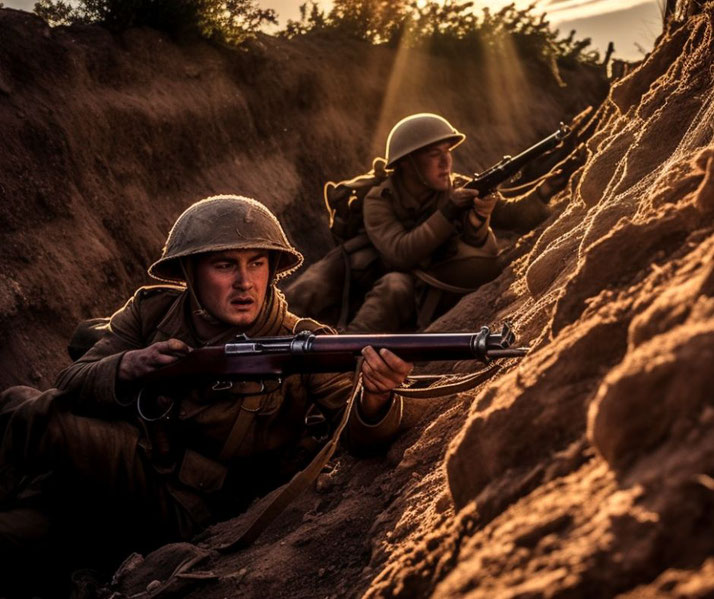The incredible Siege of Tobruk: The desert stronghold that defied Hitler's Afrika Korps

In the vast and unforgiving landscapes of the North African desert, a battle unfolded that would become a symbol of resilience, courage, and strategic importance during World War II.
The Siege of Tobruk, a grueling 240-day standoff between the Allied and Axis forces, marked a critical juncture in the North African Campaign.
Where was Tobruk and why was it important?
As World War II raged across Europe, North Africa became a critical battleground where the Axis and Allied powers vied for control over vital territories and resources.
Tobruk's geographical position made it a coveted prize. Situated on the eastern coast of Libya, its deep-water harbor and proximity to key transportation routes made it a vital logistical hub.
Control of Tobruk would not only facilitate the movement of troops and supplies but also provide a launching point for further advances into Egypt and the critical Suez Canal.
Who were the forces on each side?
The initial forces and defenses of Tobruk were a patchwork of Allied troops, including the renowned 9th Australian Division, British units, and other Commonwealth forces.
The city's fortifications were formidable, with a series of strong points, anti-tank ditches, and barbed wire entanglements.
However, the defenders were isolated, with the nearest Allied forces in Egypt, hundreds of miles away.
On the Axis side, the charismatic and tactically brilliant General Erwin Rommel led the German Afrika Korps.
Supported by Italian forces, Rommel's objective was clear: capture Tobruk and clear the path to Egypt.
His aggressive tactics and rapid advances had already earned him the nickname "The Desert Fox," and Tobruk was to be his next target.
The stage was set in early 1941 when Rommel launched his offensive into Cyrenaica, quickly capturing key towns and pushing the British back.
Tobruk remained a stubborn obstacle in his path, and its capture became an obsession for both Rommel and the Axis high command.
The Allies, recognizing Tobruk's importance, were equally determined to hold it at all costs.

The siege begins...
The Siege of Tobruk officially began on April 10, 1941, when General Erwin Rommel's Afrika Korps, supported by Italian forces, encircled the city and launched their first attacks.
The defenders, a determined mix of Australian, British, Indian, and other Allied troops, were prepared for a long and grueling battle.
What they faced was a relentless and multifaceted assault that would test their resolve like never before.
The initial attacks were fierce, with the Axis forces employing a combination of artillery bombardments, aerial strikes, and infantry assaults.
Tobruk's defenders were well-entrenched, however, and their strong points, anti-tank ditches, and barbed wire entanglements proved effective in repelling the early onslaughts.
The defenders' resistance was resolute, and the city's fortifications held firm.
Tactics and strategies on both sides were innovative and adaptive. Rommel, known for his aggressive and flexible approach, continually probed the defenses, looking for weaknesses and opportunities to break through.
The defenders, meanwhile, utilized their deep knowledge of the terrain and their fortifications to mount counterattacks and disrupt the Axis plans.
A key element of the siege was the role of the 7th Armoured Division, famously nicknamed the "Desert Rats."
Their mobile warfare tactics, utilizing tanks and armored vehicles, played a crucial role in thwarting Rommel's advances.
The Desert Rats' ability to strike and then quickly reposition kept the Axis forces off balance and contributed to the defense's success.
What were conditions like inside the city?
Life inside the besieged city of Tobruk was a study in contrasts: a blend of mundane routine and constant vigilance, moments of camaraderie and isolation, and a daily struggle for survival under the most trying of circumstances.
The Siege of Tobruk was not just a military engagement; it was a human drama that played out over 240 days and nights in the harsh desert environment.
For the soldiers defending Tobruk, the siege became a way of life. Days were filled with the routine of guard duty, patrols, and maintenance, punctuated by moments of intense combat.
Nights were restless, with the ever-present threat of artillery bombardments and surprise attacks.
The defenders, drawn from various Allied nations, formed a close-knit community, bound together by a shared mission and the hardships they endured.
Living conditions were Spartan at best. Food and water were rationed, and fresh supplies were scarce.
The desert climate added to the challenges, with scorching heat by day and freezing cold by night.
Dust storms were a frequent occurrence, adding to the discomfort and difficulty of daily life. Yet, despite these hardships, morale remained remarkably high.
Letters from home, shared stories, and a sense of purpose helped sustain the spirits of those inside Tobruk.
The challenges were not limited to the military. Civilians trapped inside the city faced their own trials.
Many were forced to take shelter in caves and improvised bunkers, living in constant fear of bombings and shelling.
The scarcity of food, water, and medical supplies took a toll, and the siege's impact on the civilian population was profound.
Supply and reinforcement were ongoing challenges. The Royal Navy played a crucial role in keeping Tobruk supplied, running a perilous gauntlet of Axis air and naval forces to deliver essential goods.
The "Tobruk Ferry Service," as it came to be known, was a lifeline for the defenders, bringing not only supplies but also news from the outside world.

Key turning points of the siege
Operation Brevity
Launched in May 1941, Operation Brevity was an Allied attempt to relieve Tobruk and push back the Axis forces.
Though initially successful in capturing key positions, the operation ultimately stalled due to strong Axis resistance and lack of reinforcements.
Despite its limited success, Operation Brevity set the stage for future Allied offensives and demonstrated the challenges of desert warfare.
Operation Battleaxe
Following the lessons of Operation Brevity, the Allies launched Operation Battleaxe in June 1941.
The goal was to break the siege and recapture territory lost to the Axis. Despite a larger force and better preparation, Operation Battleaxe met with failure.
Axis defenses, bolstered by well-placed anti-tank guns and air support, proved too strong.
The failure of Operation Battleaxe led to significant changes in British command and a reevaluation of tactics.
Operation Crusader
In November 1941, the Allies initiated Operation Crusader, a large-scale offensive aimed at relieving Tobruk and driving the Axis forces out of Cyrenaica.
After initial setbacks, the operation gained momentum, with fierce battles at Sidi Rezegh and other key locations.
The defenders of Tobruk launched a coordinated breakout to link up with the advancing Allied forces.
After weeks of intense fighting, Operation Crusader succeeded in breaking the siege and forcing Rommel to retreat. It marked a significant turning point in the North African Campaign.
How were defenders able to hold out?
Throughout the siege, both sides utilized air and naval power to support their ground forces.
The Royal Air Force and the Luftwaffe engaged in aerial duels, with control of the skies being a critical factor.
The Royal Navy's efforts to resupply Tobruk were vital to the defense, while Axis naval forces sought to disrupt these supply lines.
The interplay of land, air, and sea added layers of complexity to the battles and operations.
The 7th Armoured Division, known as the "Desert Rats," played a key role in many of the battles, employing mobile warfare tactics that countered Rommel's aggressive strategies.
Rommel's use of rapid maneuvering, deception, and integrated defenses became hallmarks of the Axis approach.
The tactical interplay between the Desert Rats and Rommel's forces added a dynamic and often unpredictable element to the conflict.
The Siege of Tobruk had implications beyond the battlefield. It became a focal point for propaganda efforts on both sides, with radio broadcasts, newsreels, and newspapers portraying the siege in terms that suited their respective narratives.
Tobruk's defenders were hailed as heroes in the Allied press, while the Axis media sought to downplay the resistance and emphasize their own successes.
How the siege came to an end
The final turning point came with Operation Crusader in November 1941. This ambitious Allied offensive aimed to relieve Tobruk and drive the Axis forces out of Cyrenaica.
After weeks of intense fighting and initial setbacks, the operation began to gain traction.
The defenders of Tobruk, coordinating with the advancing Allied forces, launched a successful breakout, linking up with the relieving forces and turning the tide of battle.
The Axis forces, worn down by months of combat and stretched thin by the demands of the broader North African Campaign, were unable to hold their ground.
General Erwin Rommel, recognizing the shifting balance of power, ordered a strategic withdrawal.
The retreat marked not only the end of the siege but also a significant reversal of fortunes for the Axis in North Africa.
The cost of the Siege of Tobruk was high for both sides. Thousands of soldiers were killed, wounded, or captured, and the toll on equipment and resources was substantial.
The human and material losses reflected the intensity and duration of the siege, with both sides paying a heavy price for their respective gains and objectives.
The lifting of the siege was met with jubilation by the defenders and a sense of relief and accomplishment by the Allied command.
Tobruk's resistance had become a symbol of Allied determination, and its liberation was a morale boost for the entire war effort.
For the Axis, the loss of Tobruk was a setback but not a defeat. Rommel regrouped and continued to fight, and the North African Campaign raged on.
The end of the siege was a turning point, but it was not the end of the struggle in the desert.
The city itself bore the scars of the prolonged battle. Buildings were damaged or destroyed, infrastructure was in disarray, and the civilian population faced the daunting task of rebuilding and recovery.
What do you need help with?
Download ready-to-use digital learning resources
Copyright © History Skills 2014-2024.
Contact via email
With the exception of links to external sites, some historical sources and extracts from specific publications, all content on this website is copyrighted by History Skills. This content may not be copied, republished or redistributed without written permission from the website creator. Please use the Contact page to obtain relevant permission.





